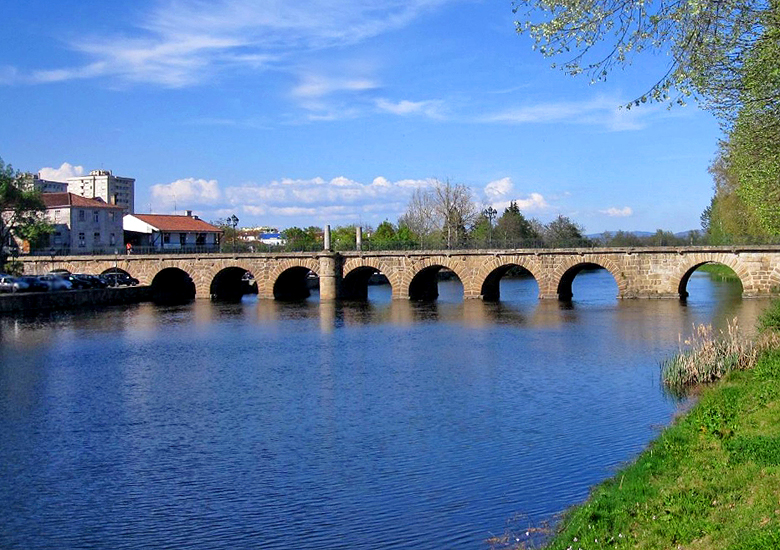Chaves is a Portuguese city in the Vila Real District, in the North Region and sub-region of Alto Tras-os-Montes.
With about 19,300 inhabitants. It is the seat of a municipality with 590.42 km² of area and 44 186 inhabitants (2006), subdivided into 51 parishes. The municipality is bordered on the north by Spain, east by the municipality of Vinhais, southeast by Valpacos, southwest by Vila Pouca de Aguiar and west by Boticas and Montalegre.
About : Chaves was already inhabited before the time of the Roman Empire, since prehistory. About two millennia ago, the Romans occupied the site, built monuments like the bridge of Trajan and named the city Aquæ Flaviæ . Later, the Suevi, the Visigoths, and the Alans from eastern Europe put an end to Roman occupation. With the Arabs, Islam also invaded the space once occupied by Christianity. Chaves was later reconquered in the 9th century by D. Afonso, king of Leon. But in the early 10th century Chaves was conquered again by the Moors until, in the 11th century, D. Afonso III, king of Leon, rescued it , ordered to rebuild, to settle and to surround again of walls.
Around 1160, Chaves is part of Portugal. Due to its frontier situation, Chaves was vulnerable to attack by invaders and as a protection measure . Dinis had the castle and the walls that still dominate a large part of the city and its periphery built.
Access : Coordinates: 41.740556, -7.471389 / By airplane : Chaves is just 50 km from Vila Real and has regular domestic flights daily. Chaves also has an airport with essentially recreational or private flights.
By boat : You can enjoy beautiful walks by the river Tamega in rowboat rented next to the Roman Bridge. By train : There is no train line to Chaves By bus : From Porto and Lisbon , By car : By the N2 from Vila Real. You can also use A24 or A7.
Highlights :
- Igreja da Misericórdia (Praca Caetano Ferreira – Chaves) – It is considered by many to be the most beautiful church in the city. It has a baroque facade from the 17th century with plinths and capitals well crafted. The interior of a single nave features walls lined with tile panels and biblical motifs.
- Igreja Matriz (Praca de Camoes – Chaves) – It is a Romanesque temple, altered in the 16th century and, therefore, has Renaissance characteristics.
- Igreja da Madalena or Igreja de São João de Deus Church of St. John of God (Rua Sao Joao de Deus – Chaves) – It is on the left bank of the Tamega. It goes back to the eighteenth century, with the dominant style being the Renaissance and the Baroque. Due to its dome, it is easily recognized from afar. The interior is of a single nave, being the octagonal plan.
- Forte de São Francisco – Fort of Sao Francisco (Alto da Pedisqueira – Chaves) – Built between 1658 and 1662, it has a quadrangular plan. In the interior the church of S. Francisco was maintained. It is currently a hotel.
- Forte de São Neutel – Sao Neutel Fortress – It has a structure similar to that of the Sao Francisco Fortress. It has an outer wall. This is because the strong is not connected to the defensive system of Chaves. The walls are thick and 10 meters high. Inside the fort is maintained the Chapel of Our Lady of the Brotas.
- Library (Largo de Camoes – Chaves)
- Museum of the Flavian region (Paco dos Duques de Braganca – Chaves) – It has great archeology collections from the Roman period, as well as some ethnography of the region.
- Castle of Chaves – From the well-preserved Tower of Menagem one has a magnificent view of Chaves and the surrounding lands. Part of the castle wall survived as well. In the middle there is a beautiful garden where are exposed some parts of the military museum installed in the tower.
- Military Museum
- Termas de Chaves – Hot Spring (Largo Flavio Vespasiano – Chaves) – They are world famous and at least as old as the Roman occupation. The bicornornated, sodium and hyperthermal waters leave at 73 C, being the hottest in Europe.
- Roman Bridge or Trajan – Built between the 1st and 2nd century AD, there are twelve visible arches and four buried under the alluvium. It is made of granite and is a National Monument.
- Chapel of Our Lady of Loreto or Chapel of the Holy Head – Igreja da Madalenaor Igreja de São João de Deus (Praca de Camoes – Chaves) – Next to the Municipal Council of Chaves, it has a granite facade and high pilasters. It is surmounted by a curved pediment. Built in 1696, tradition says that here is buried the Martyr Saint Bonifacio
Activities : Visit the historical center and the recent archaeological discoveries in the city. / Drink water at the Termas de Chaves / A boat trip through the Tamega River in rowboats
Go next : Vidago / Pedras Salgadas / Braganca.

